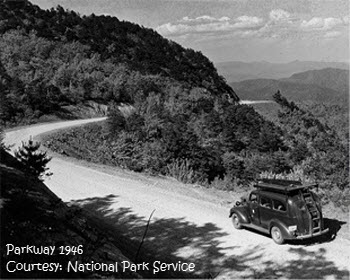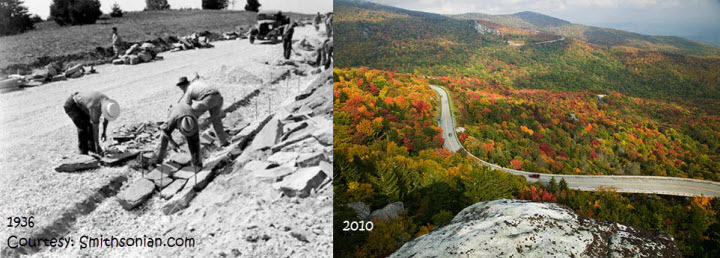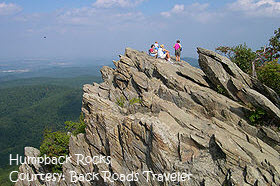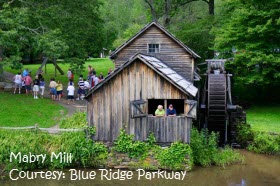 Celebrating its 78th anniversary this year, 2013; the Blue Ridge Parkway was not always the beautiful and captivating 469 mile, scenic “all American road” we know and enjoy today. The project was commissioned by then president, Franklin D. Roosevelt as a means to boost the economy during the great depression of the 1930’s and connect Shenandoah National Park to the Great Smoky Mountains National Park. Construction begun near Cumberland Knob, North Carolina September 11, 1935: less than a year later, work began in Virginia in February, 1936. The project was first called Appalachian scenic Highway and was operated by the Federal Public Works department. Congress approved the name change to the Blue Ridge Parkway on June 30, 1936 and granted the National Park Service jurisdiction over the project.
Celebrating its 78th anniversary this year, 2013; the Blue Ridge Parkway was not always the beautiful and captivating 469 mile, scenic “all American road” we know and enjoy today. The project was commissioned by then president, Franklin D. Roosevelt as a means to boost the economy during the great depression of the 1930’s and connect Shenandoah National Park to the Great Smoky Mountains National Park. Construction begun near Cumberland Knob, North Carolina September 11, 1935: less than a year later, work began in Virginia in February, 1936. The project was first called Appalachian scenic Highway and was operated by the Federal Public Works department. Congress approved the name change to the Blue Ridge Parkway on June 30, 1936 and granted the National Park Service jurisdiction over the project.
Blue Ridge Parkway 101
The parkway sits on approximately 88,000 acres of land, snaking through twenty-nine counties; 168 bridges and six viaducts were used to support the parkway over streams, railway ravines and across roads. Although many lands were offered up by the government, farmland and other private property had to be obtained for use. Plans for the Parkway was met with skepticism by landowners and some local communities, however, through the assistance of several agencies and persons at local, state and federal levels; the project went underway and was successful as is evident today. Architect Stanley W. Abbott’s (responsible for Blue Ridge design) vision was that the Parkway maintain its natural scenery and preserve the history of the lands which the road occupied while providing its visitors with locations to hike, fish, picnic or camp. Hence, there are no billboards, traffic lights or stop signs, and all utilities are buried; signs are limited, with mile markers being the one constant on the Parkway. The Parkway is a two-lane road and widens at specific areas to allow parking for breathtaking views and other amenities.

Activities along the Blue Ridge
Since 1946 the Blue Ridge Parkway has seen more visitors than any other national park throughout the US: averaging approximately 18 million visitors each year. Forget about the destination for a bit and enjoy your journey along the Parkway: experience a bird’s-eye view of the river valley or witness the tranquility of cattle grazing in a nearby pasture. There is so much to see and do, if you will take the time. Join the millions who have visited before you and check out some of these locations.
 Humpback Rocks – At milepost 5.8 you’ll find impressive natural beauty, a rich history of early settlers and a wide range of hiking trails suitable for all ages. Follow the mountain trail and tour the 19th century farm buildings occupied by European settlers who made their living by harvesting materials such as logs, rocks, chestnuts and hickory from the Appalachian Mountains. Visit the museum at the visitor’s center, enjoy a picnic and maybe overnight camping at Sherando Lake, four miles away.
Humpback Rocks – At milepost 5.8 you’ll find impressive natural beauty, a rich history of early settlers and a wide range of hiking trails suitable for all ages. Follow the mountain trail and tour the 19th century farm buildings occupied by European settlers who made their living by harvesting materials such as logs, rocks, chestnuts and hickory from the Appalachian Mountains. Visit the museum at the visitor’s center, enjoy a picnic and maybe overnight camping at Sherando Lake, four miles away.
James River & Otter Creek – take a walk next to the creek; 3.5 miles long, it runs from the Otter Creek Campground to the James River Visitor’s Center. If you desire a relaxed area for fishing this is the ideal spot for you. Catch warm water fish sitting or standing on the pier on Otter Lake, which is also wheelchair accessible. You might also want to take a look at the restored battery creek lock before you leave.
 Rocky Knob & Mabry Mill – get a firsthand look at one of the most photographed locations/structure along the Parkway. Like many other locations along the Blue Ridge, you’ll find a few hiking/biking trails along with picnicking and camping areas. However, Mabry Mill is a premier location; during the summer months, musicians and dancers gather every Sunday afternoon, providing live entertainment. Take a hike into Rockcastle Gorge or explore the historical exhibits located around the mill for great information about life in rural Virginia. You will find exceptional agriculture along the trails and roadway; you will develop a new appreciation for the beauty of nature.
Rocky Knob & Mabry Mill – get a firsthand look at one of the most photographed locations/structure along the Parkway. Like many other locations along the Blue Ridge, you’ll find a few hiking/biking trails along with picnicking and camping areas. However, Mabry Mill is a premier location; during the summer months, musicians and dancers gather every Sunday afternoon, providing live entertainment. Take a hike into Rockcastle Gorge or explore the historical exhibits located around the mill for great information about life in rural Virginia. You will find exceptional agriculture along the trails and roadway; you will develop a new appreciation for the beauty of nature.
The Blue Ridge Parkway offers spectacular viewpoints, light to intense outdoor activities and is full of rich history of early settlers to Virginia. Every minute spent on the Parkway or at any one of the mileposts locations will be well worth it. You’ll gain an experience not easily forgotten.
For incredible photography check out pictures of the blue ridge parkway from our friends over at Blue Ridge Parkway Daily.
For further information about Blue Ridge Parkway visit the following sites:
http://docsouth.unc.edu/blueridgeparkway/about/about_parkway/parkway/
http://www.smithsonianmag.com/history-archaeology/75-Years-of-the-Blue-Ridge-Parkway.html
For more “what to do” information visit:
http://www.blueridgeparkway.org/v.php?pg=68
http://www.virginia.org/blueridgeparkway/
